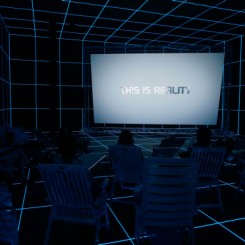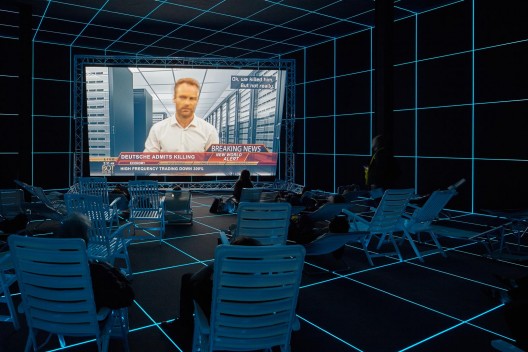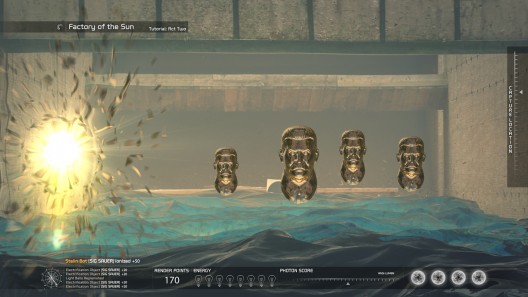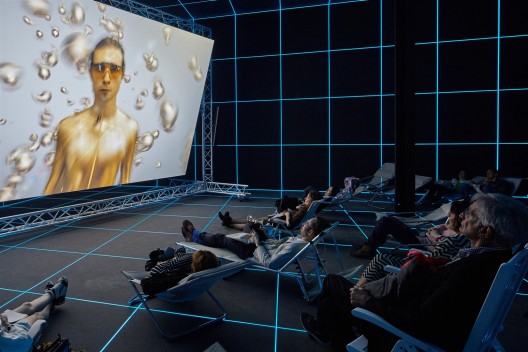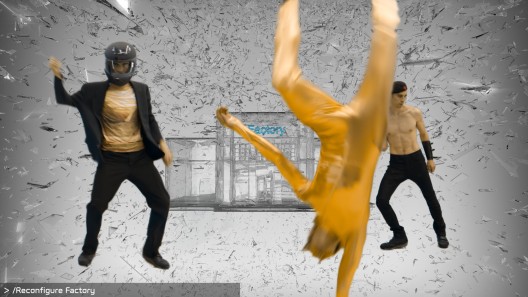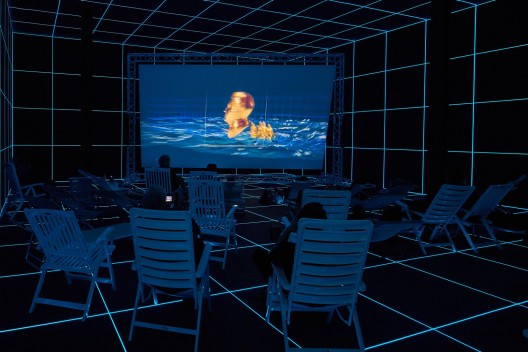Ran Dian would like to thank Mathieu Borysevicz and BANK, the studio of MABSOCIETY Shanghai, for generously facilitating this interview.
This piece is included in Ran Dian’s print magazine, issue 2 (Winter 2015–2016)
Hito Steyerl (b. 1966, Munich) is coruscating and forensically meticulous in her critique of how images circulate, are transacted, and are stored in free ports. She is a writer, teacher, filmmaker, and installation artist. But most of all, Hito Steyerl is a moral philosopher of the politics of images. Her installation for the German Pavilion in Venice was not entertainment: it was a call to arms.
Hito Steyerl: I’m actually writing about this Marx quote: the first time in history was a tragedy; the second time is a farce. I’m saying, “We have to get rid of it.” If we keep on quoting, it’s worse than the farce, actually. [Laughing] We have to just throw it out the window because it’s not helping right now. But the time of gaming is very important in that respect, because in a video game we have a similar rule, right? You die, you respawn, you die again, but…
Zian Chen: You never really die.
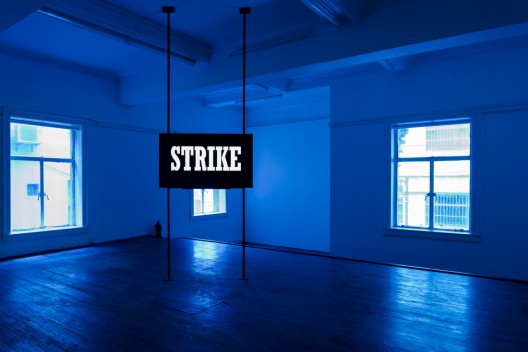
“The BANK Show, Hito Steyerl” ,展览现场图,BANK,上海,2015.7.18 – 2015.8.30(摄影:王闻龙,图片提供:BANK,上海)Hito Steyerl, “The BANK Show, Hito Steyerl”, installation view at BANK, Shanghai. Photo: Alex Wang. Courtesy of BANK, Shanghai.
Hito Steyerl: You don’t die, but on the other hand you do something in the meantime: you improve your skills. So something is actually happening and you would manage eventually, if you were to go to enough forums to get to another level, right? So it’s possible—history doesn’t have to repeat; the eternal return doesn’t have to happen. It can unlock the achievements. [Laughing] It’s just a matter of practice. So in that sense, I think gaming temporalities are very hopeful—much more hopeful than Marx.
Chris Moore: The Da Vinci Code! [Laughing] Are we talking about being within or without the critical system, in the sense that we are automatically part of the system? For instance in the art world, you’re exhibiting in commercial galleries and so there’s always a compromise one has to negotiate or reconcile oneself to. What’s your thinking on this? Because a lot of your work is really criticizing this environment?
Hito Steyerl: Oh! You caught me in a contradiction! CONGRATULATIONS, YOU GET 20 POINTS!
Zian Chen: What about the poor image?
Hito Steyerl: You know, the “poor” image as I described it existed from 2007 until maybe around 2009, then the bandwidth was much amplified. So most images you see on your phone now are very highly resolved— the poor image doesn’t exist in this form anymore. Even on YouTube, most material is HD now. High Definition is the new Standard Definition. So, it’s relative, right?
Zian Chen: The poor quality image—to use that now is really a type of nostalgia, or a commodification of memory.
Hito Steyerl: You know, you cannot fix this particular shape in time and say, “This is going to last for the next 20 years.” It isn’t. The poor image today is very different than it was some years ago. It’s also not as symptomatic as a cultural form.
Chris Moore: Back in November, you already talked about the notion of, “The story tells me”; I feel it really informs the current wave of your thinking. Then, you suddenly made a reversal of it. The fictional mode is actually a real mode or something. I think you kind of layer up the relationship between inside and outside or the one in the narrative and the one outside it. Would you talk about where this originates from, this kind of quick storytelling?
Hito Steyerl: I’m never in control of the story—maybe someone is; usually that’s much more interesting because then things can happen all the time. I don’t see the reversal you see, either. It’s kind of a good example: I am constantly told I did this or that, and I really can’t remember any of it.
Chris Moore: When you raised the issue of professionalism before, I was wondering about all the political systems there are in society. There is a system of categorization for people, and in Britain it’s also a commodification of status—do you think of yourself as an artist? Or is that just completely unhelpful and irrelevant? Do we need to put that to one side and get rid of all these categorizations?
Hito Steyerl: I don’t mind; I never call myself an artist. I don’t feel qualified to do that—I cannot draw. I do not know art history. I’m confident in filmmaking, I know film history, I can operate most of the hardware—but artist? On the other hand, it is true that the art field has given me a forum to present my work which I wouldn’t have had anywhere otherwise. I’m not resisting it—it will be over soon anyway. I just don’t know what it means to be called an artist. An “elephant” would mean just the same. I am not opposed to elephants.
Chris Moore: But I think that’s a very important thing in this massive, hypercapitalist system we’ve been discussing with regard to art and how art has become quite absurd and grotesque. It is easy to criticize, to laugh at how expensive a Jeff Koons work is—but all of these things leak into our society. I’m thinking of the philosophical structures in society, and they change you. They change everyone. How can we use these critical films and installations you’re creating to effect change?
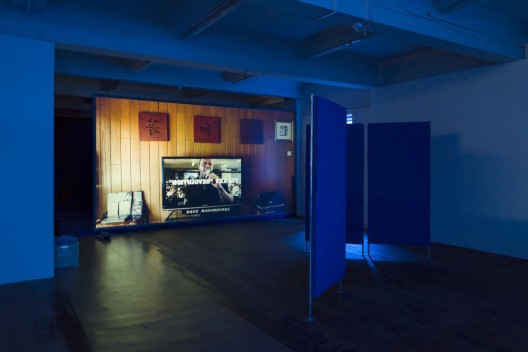
“The BANK Show, Hito Steyerl” ,展览现场图,BANK,上海,2015.7.18 – 2015.8.30(摄影:王闻龙,图片提供:BANK,上海)Hito Steyerl, “The BANK Show, Hito Steyerl”, installation view at BANK, Shanghai. Photo: Alex Wang. Courtesy of BANK, Shanghai.
Hito Steyerl: That’s up to you—I’m doing a lot of work already making the work; [Laughs] I can’t possibly assist with that. I never promised anyone that I will make the work that is going to change the world; but maybe if you all put it in a heap you could try to throw it at someone. Try making a lasso with cables, for starters. You could try to catch a sheep and start a flock. Some Italian guys are trying to take the installation material from Venice to Kobane to rebuild the Women’s House there; I think that’s a really good example of how the trash form of something can be infinitely more complex and interesting than the intact and seemingly new object, and how things can be recycled as something completely different. It’s the works’ next level, and someone else is creating it. Not me. There will also be other people recycling the work on parallel levels, for example for its impending online release. I am very happy about that, but I am not in charge.
Zian Chen: So, would you just say it’s one of the points where you back your case for Marxism in a way that you don’t hold your films to a kind of responsibility to change the world? Could you say more about your attitude towards the “zombie” or historical Marxist breed of thinking?
Hito Steyerl: On Wikipedia there is lots of advice on how to deal with zombies: “To kill a Zed, take out your (preferably bladed) melee weapon, raise your fists (Spacebar) and enter into the first-person view (Enter).” Of course, things get more challenging if you are the zombie.
Chris Moore: We have a super excess of images, and at the same time have to repeat these images. It seems a strange situation we’ve put ourselves into; what are your strategies for dealing with this?
Hito Steyerl: With what? Having to repeat images?
Zian Chen: It’s not that new.
Hito Steyerl: Well, it’s not even about novelty; it’s not that things have to be shiny and fresh, that’s not the point. Please, if you want something new, go to the mall. They will answer all your questions and point you to the correct product. I have a feeling you are talking to the wrong person, basically, all the time. I am not that super macho pouncing about and telling you he has all the answers and showing his teeth to intimidated grad students. You have to find such a person. He will give you all the answers.
Chris Moore: And we are in a situation wherein they are all asking “now what?” but there are no answers, apparently.
Hito Steyerl: Yes, but I think there are lots of different people working all over the place to invent things from all sorts of different angles. In the countryside people are trying to basically live together. It sounds like nothing, but it is everything.
Chris Moore: It’s just the beginning.
Hito Steyerl: Exactly.
Zian Chen: There’s a sort of CNN format of adjusting to that newness.
Hito Steyerl: Yes, of course.
Zian Chen: And the other way is about a kind of connective sense of location to the future…
Hito Steyerl: I love how you are answering your own questions because, really, it seems someone has to do it. Okay, let’s just drop this notion of the new—I think it’s kind of misleading. I was criticizing the fixation and its genealogy and origin. The idea was that you’re not defined by the past, but by what Hannah Arendt called “natality.”
Chris Moore: Quotation is also a trap, isn’t it?
Hito Steyerl: 20 POINTS FOR YOU, AGAIN!
I still feel very close to Benjamin’s way of writing columns; for now, it’s fine. [All laugh] It’s not useless— absolutely not. It’s a perspective of observation. I still feel close to someone walking through the streets and observing. Let’s talk about some robots now, finally. [Laughs]
You see, Benjamin is often at his best when he’s being mistranslated. For example, there is an interesting mistranslation in one English edition wherein Benjamin is apparently talking about the fascist way of processing data. But the point is, Benjamin never wrote about data, he wrote about factual events. But it’s interesting because if you follow the mistranslation, it’s much more productive.
Chris Moore: Is this where your “wreckage” thinking comes from?
Hito Steyerl: It would probably be much more productive if we go on mistranslating him in every language….
Chris Moore: Maybe that’s a way out of the system—the glitches and the errors.
Hito Steyerl: No, there is one universe—or maybe there are several parallel universes; let’s discuss it on the level of physics, then. I mean, seriously, not just pretending. Pretend I’m not there, right? [Laughs] I know this is the being outside the system. I know, too, I do not belong.

